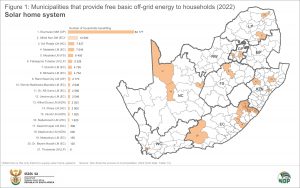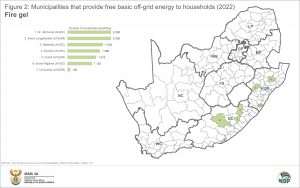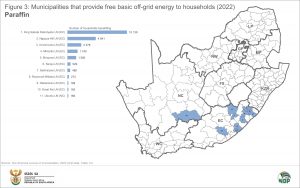Solar energy for the poor
Households and businesses are adopting alternative sources of energy as load shedding bites. What may not be well known is that many municipalities are in the game too, providing off-grid energy sources to the poorest households.
The Free Basic Alternative Energy (FBAE) policy1 instructs municipalities to supply alternative sources of energy to poor households that are not connected to the grid. The policy was introduced to aid predominantly rural municipalities that struggled to provide Free Basic Electricity (FBE) to a relatively high number of indigent households in un-electrified areas. The policy lists several alternatives, such as coal, liquefied petroleum gas, bio-ethanol gel (or fire gel) and paraffin. Although not specifically listed, municipalities also provide solar home systems.
Stats SA tracks the municipal rollout of alternative sources of energy in its annual Non-financial census of municipalities statistical report. The agency covered the 2017 data in a summary article published in 2018.2 The most recent release provides a 2022 update for data on solar, fire gel and paraffin.
The maps below show where these services are provided. Of South Africa’s 257 municipalities, 21 municipalities across 7 provinces supplied solar home systems to 149 919 households (Figure 1). This is up from 113 197 households in 2017.
The Ekurhuleni Metropolitan Municipality in Gauteng provided solar home systems to the largest number of households in 2022, followed by Alfred Nzo District Municipality in Eastern Cape and Sol Plaatje Local Municipality in Northern Cape.
Of particular interest is the concentration of municipalities in the northern parts of Eastern Cape, where two administrative levels provide the service across the same area. Alfred Nzo District Municipality, as well as its four local municipalities, are all actively involved in rolling out solar home systems.
Fire gel is another off-grid energy alternative. In 2022, 7 municipalities supplied fire gel to 9 702 households in KwaZulu-Natal and Eastern Cape (Figure 2). This is much lower than the 19 607 households that benefitted from the service in 2017.
The use of paraffin by South African households in general has declined over the years, according to census data from 1996 to 2022. In 1996, 21,6% of all households used paraffin as a source of energy for cooking, falling to 8,5% in 2011 and further to 2,7% in 2022.3
Municipal support programmes have also scaled back in this regard. In 2022, 11 municipalities supplied paraffin to 22 421 households (Figure 3), lower than the 86 522 households in 2017.
Several municipalities provided other alternative sources of energy, such as coal, liquefied petroleum gas and candles. In the report, these sources are grouped into the category ‘other’ and include a total of 11 248 households: 10 910 in 5 Eastern Cape municipalities and 338 in 1 Northern Cape municipality.
In summary, of the three main alternative sources of energy measured, municipalities have increased their supply of solar systems to assist poorer households, while fire gel and paraffin have become less prominent.
For more information, download the 2022 Non-financial census of municipalities report and unit data here. Tables 13 and 14 include information on alternative energy.
1 Department of Minerals and Energy (South Africa). (2007, April 2). Free Basic Alternative Energy Policy: Households Energy Support Programme (Notice 391). Government Gazette, 29760, p. 3 (download here).
2 Stats SA, Energy and the poor: a municipal breakdown (read here).
3 Stats SA, Census 2022, Statistical release (P0301.4), Figure 8.15 (download here).
Similar articles are available on the Stats SA website and can be accessed here.
For a monthly overview of economic indicators and infographics, catch the latest edition of the Stats Biz newsletter here.




